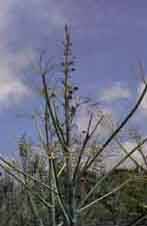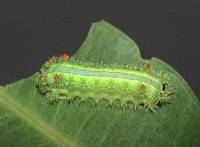TNAU Agritech Portal :: Castor
1. Serpentine leaf miner: Liriomyza trifolii |
|
|
Leaf mining damage |
Leaf miner - Adult |
|
Symptoms of damage
- Drying and dropping of leaves
Identification of the pest
- Larva - minute, orange yellowish in colour and apodous
- Adult - pale yellow colour fly
Management
- Spray neem seed kernal extract (NSKE) 5% or triazophos @ 2.5ml/litre of water.
|
|
2. Castor Semilooper: Achaea janata, Paralellia algira |
 |
Damage |
|
Symptoms of damage
- Damage to complete defoliation.
- leave bare stems & veins
A) Identification of the pest - Achoea janata
- Larva- semilooper with varying shades of colour with black head.
- Abdomen – has a red spot on the third abdominal segment and red tubercules in the anal region
- Adult - pale reddish brown moth with hind wing having white spot in the middle and three large white spots on the outer margin
|
|
B) Identification of the pest - Paralellia algira
- Larva- semilooper, olive grey colour with numerous longitudinal lines
Adult
- Fore wing - white in colour with suffused band beyond it.
- Hind wing: - has white median band, the outer margin grey at centre.
|
| Management
Spray any one of the following insecticides thrice from flowering at three weeks interval :
- Malathion 50 EC 2.0 l / ha
- Carbaryl 50 WP 2.0 kg / ha in 1000 l of water
- Apply neem seed kernel extract 5% + Neem oil 2%
|
|
3. Castor Slug: Parasa lepida |
Symptoms of damage
- Feed gregariously on the leaves of castor and later spread over to the entire plant.
- Cause defoliation – leaving only the midrib and veins
Identification of the pest
- Larva- slug like, ventrally flat, greenish body with white lines and four rows of spiny scoli tipped red or black
- Adult: - green moth with brown band at the base of the forewin
|
|
 |
Management
- The pest should be kept in check by picking the gregarious caterpillars and the cocoons which are found on tree trunks and destroying them in water with a film of kerosene.
- Spray chlorpyriphos or Quinalphos @ 2 ml per litre of water if pest attack is more.
|
|
4. Tussock caterpillar: Orgyia (=Notolophus ) postica |
Symptoms of damage
Management
- To control early stage larvae, spray neem seed kernel extract (NSKE) 5% or spray chlorpyriphos 2.5ml or quinolphos 2ml or neem oil 5ml per litre of
Identification of the pest
Larva
- Head –brown in colour. Prothorax with a pair of long pencils of hairs pointing forward
- Abdomen – laterally - first two segments have tufts of yellowish hair.
- Long brown hairs from the 8th segment onwards
Adult
- Male moth with brown coloured with stout abdomen. Female apterous water.
|
|
5. Hairy caterpillars: Euproctis fraterna, |
Symptoms of damage
A) Identification of the pest - Euproctis fraterna
- Larva - Reddish brown hairy caterpillar
- Head – red in colour surrounded by white hairs
- Abdomen – has tufts of hairs all over the body and a long pre anal tuft.
- Adult - yellow moth with pale transverse lines and black spots on the forewing.
B) Identification of the pest - Porthesia scintillans
- Larva: - Yellow coloured hairy caterpillar
- Head – brown in colour
- Abdomen- has yellow stripes with a central red line on the body
- Adult - yellowish with spots on the edges of the forewing.
C) Identification of the pest - Dasychira mendosa
- Larva: Greyish brown with dark prothoracic and pre-anal tufts,
- Prolegs crimson coloured
Management
- To control early stage larvae, spray neem seed kernel extract (NSKE) 5% or spray chlorpyriphos 2.5ml or quinolphos 2ml or neem oil 5ml per litre of water.
|
|
6. Woolly bear: Pericallia ricini |
Symptoms of damage
Identification of the pest
- Larva- black with brown head having long brown hairs.
- Adult: grey coloured moth. Hind wings are pinkish with dark spots
Management
- To control early stage larvae, spray neem seed kernel extract (NSKE) 5% or spray chlorpyriphos 2.5ml or quinolphos 2ml or neem oil 5ml per litre of water.
|
|
7. Castor spiny caterpillar: Ergolis merione |
Symptoms of damage
Identification of the pest
- Larva- green coloured, spiny caterpillar with yellow stripe on the dorsal region
- Adult: Brown butterfly with black wavy lines on the wings
Management
- To control early stage larvae, spray neem seed kernel extract (NSKE) 5% or spray chlorpyriphos 2.5ml or quinolphos 2ml or neem oil 5ml per litre of water.
|
|
8. Red hairy caterpillar: Amsacta albistriga, A. mooreii |
Symptoms of damage
- These hairy caterpillars scrap the under surface of the leaf when they are in neonate stage.
- Later the scrapped patches of the leaves looks like thin papery
- Full grown larvae devour the entire foliage, flowers and growing points.
Identification of the pest
- Larvae- hairy caterpillar reddish brown with black band on either end having long reddish brown hairs all over the body.
- Adult: - moth with white wings
 |
Amsacta albistriga
- Forewing - white with brownish streak all over and yellowish streak along the anterior margin and head
- Hind wing – white with black markings
Amsacta moorei
- Forewing - white with brownish streak all over and reddish streak along the anterior margin and hea
|
|
Management
- Collection and destruction of egg masses and hand picking of larvae
- The barnyard millet (Echinochloea frumentacea.) may act as strong barrier
- Summer ploughing and poison baiting.
- Erection of light traps soon after the monsoon for 20-45 days and collecting and killing of adult moths are found to be very effective.
- The dispersing larvae of hairy caterpillar from one field to another can be checked by digging trenches across the direction of their march, and prompt destruction of larvae.
- Vegetative traps utilizing Jatropha (wild castor) or Ipomea prevent the migration of the grown up larvae.
- Prepare small balls with10 kg rice bran + 1 kg jaggery +1 liter quinolphos broad-cost in the fields preferably in the evening times.
- Dusting of carbaryl or quinolphos @ 25-30 kg/ha would be effective in the control of young larvae.
- Use of 200 ml dichlorovos 100 EC dissolved in 400 litres of water/ha may be used to control grown up caterpillars. or
- Spray QuinalPhos or dimethoate 2ml /lit of water.
|
|
9. Tobacco caterpillar: Spodoptera litura |
|
Symptoms of damage
- The early instar larvae feed gregariously on the under surface of the leaf leading to skeletonization of the leaves.
- Sometimes the feeding is so heavy that only petioles and branches are left behind.
- In case of severe attack cause complete defoliation.
Identification of the pest
- Egg - Egg masses appear golden brown
- Larva - Pale greenish with dark markings. Gregarious in the early stages
- Adult - Forewings – brown colour with wavy white markings. Hind wings- white colour with a brown patch along the margin
|
Management
- Collect and destroy the egg masses and caterpillars in the early stages of infestation.
- Plough the field so as to expose the pupae to predators and parasitoids
- Monitoring the pest with pheromone traps (4-5/acre) helps in timely treatment.
- To control early stage larvae, spray neem seed kernel extract (NSKE) 5% or chlorpyriphos 2.5ml or quinolphos 2ml or neem oil 5ml per litre of water.
- As the grown up larvae move down to soil to hide during day time, poison bait (1 litre of 1kg carbaryl + 10kg of rice bran + 1 kg jaggery + 1 litre of water to make the bait in to pellets for one hectare) placement at base of the plants helps in killing the larvae.
|
|
10. Bihar Hairy Caterpillar: Spilosoma obliqua |
|
Symptoms of damage
- Young larvae feed gregariously mostly on the under surface of the leaves.
- A caterpillar of later stages defoliates the field completely.
Identification of the pest
- Eggs -are laid in clusters of 50-100, on the lower side of leaves.
- Larvae - orange coloured with broad transverse band with tufts of yellow hairs that are dark at both ends
- Pupa- forms a thin silken cocoon by interwoven shed hairs of the larvae.
- Adult - crimson coloured moth with black dots and a red abdomen. Wings – pinkish with numerous black spots
Management
- Collection and destruction of eggs and early stage larvae
- Spray NSKE 5% to kill early stage larvae.
- If grownup larvae are seen, spray quinalphos, chlorpyriphos @ 2ml/litre of water
|
|
11. Capsule Borer: Conogethes (=Dichocrosis) punctiferalis |
|
Symptoms of damage
- Capsule with bore holes.
- Damaged capsules webbed together
- Peduncle and capsules showing galleries made of silk and frass.
Identification of the pest
- Larva: - pale greenish with pinkish tinge and fine hairs with dark head and prothoracic shield
- Adult – yellowish with black spot
|
|
Management
Spray any one of the following insecticides, thrice from flowering at three weeks interval :
- Malathion 50 EC 2.0 l /ha
- Carbaryl 50 WP 2.0 kg / ha in 1000 l of water
|
|
12.Jassids: Empoasca flavescens |
|
|
Symptoms of damage
- Leaf margins become yellow
- Curling of leaf edges and leaves turn red or brown.
- Leaves dry up and shed.
Identification of the pest
- Nymph: green coloured
- Adult: green wedge shaped insect
|
Management
- Seed treatment with imidacloprid or carbosulfan or stem application with protects the crop from all sucking pests including jassids for about a month.
- Spray dimethoate (0.05%). Repeat spray if required after a fortnight
|
|
13. White flies: Trialeurodes ricini |
Symptoms of damage
- Water soaked spots on the leaves which become yellow and dry up
- Leaves appear sickly and get coated with sooty mould.
- Stunted plant growth, shedding of fruiting bodies
Identification of the pest
|
Management
- Whiteflies can be effectively attracted and controlled by yellow sticky traps, which are coated with grease/sticky oily materials.
- Spray triazophos (2.5 ml/l) or acephate (2 ml/l).
- Spraying of any neem product (NO 3% or NSKE 5% ) with any sticky material.
- Use of synthetic pyrethroids increases the intensity of whitefly.
|
|
|
14. Thrips: Retithrips siriacus: Scirtothrips dorsalis |
|
Symptoms of damage
- Terminal leaves silvered
- The injury results in development of dull yellowish-green patches on the upper leaf surface and brown necrotic areas of the lower surface.
- Under heavy infestation the leaves curl and plants get stunted.
|
Identification of the pest
- Nymph: Pinkish (Retithrips siriacus); yellowish (Scirtothrips dorsalis)
- Adult: Black with fringed wings
Management
- Insecticides such as dimethoate, methyl-o-demeton at the rate of 2.0 ml per litre of water give control of thrips effectively.
- neem oil (1 lit) + soap powder (1 kg) in 200lit of water can be sprayed twice at 10days interval
|
|
|

